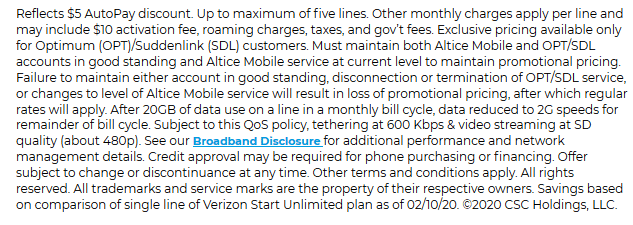Post redacted


Post redacted

Alice Mobile recently increased its prices by $10 per month. Service now costs $30 each month for Optimum or Suddenlink customers and $40 per month for everyone else.
In September, I argued that Altice Mobile was doing a lousy job of disclosing the limitations that came with the carrier’s supposedly “unlimited” plan. Given the recent price increase, I figured now would be a good time to revisit Altice Mobile’s policies.
Altice is still imposing a lot of limits on its “unlimited” plan:1
Previously, video and hotspot traffic would be throttled more intensely after 50GB of use. It looks like Altice has decreased that threshold to 20GB.
Altice continues to advertise “unlimited everything.” Here’s a screenshot from Altice’s website today:

As before, it’s misleading for Altice to suggest subscribers can stream an unlimited amount of video or use an unlimited amount of mobile hotspot data. After 20GB of use, subscribers will be throttled to a maximum speed of 128Kbps for video and hotspot traffic. At 128Kbps, continuous streaming of conventional video won’t be possible.2 Many activities subscribers will want to do over a hotspot connection will be frustratingly sluggish if not impossible.3
To Altice’s credit, it looks like the carrier is doing a bit better disclosing limitations. With a single click, website visitors can view additional information:

Altice’s Broadband Disclosure Information seems easier to find than it was previously. While the disclosures still fall short of being explicit or easy-to-understand, Altice is moving in the right direction.

AT&T has settled with the Federal Trade Commission (FTC) and agreed to pay out $60 million to current and past customers that may have been affected by misleading claims about unlimited data. The settlement is in response to the FTC’s 2014 accustation that AT&T failed to adequately disclose that customers on unlimited data plans could have their speeds throttled substantially. Here are a few bits from the 2014 FTC complaint:
Here’s an excerpt from the FTC’s press release from today (emphasis mine):
I’m glad to see the FTC cracking down on misleading practices. Bogus “unlimited” plans seem to be much more common today than they were in 2014.

5/17/2020 update: Xfinity’s 1GB plan that was $12 per month at the time this post was written is now $15 per month.
One of my recent posts about Xfinity Mobile received a comment on Reddit that got me thinking:
Let’s dive into that. It’s not always possible to make apples-to-apples comparisons among carriers since each carrier has its own way of structuring plans. Still, I’ll try my best to compare Xfinity Mobile’s prices to the best deals available from Verizon and other carriers that use Verizon’s network.
Both the commenter and I think Xfinity Mobile may be a good option for people who don’t use a lot of data. For a base price of $12 per line, Xfinity Mobile offers a 5-line plan with unlimited minutes, unlimited texts, and 10GB of shared data. In comparison, a postpaid Verizon plan with 8GB of shared data, unlimited minutes, and unlimited talk would have a base price of $34 per line. It’s harder to make a close comparison with Verizon’s prepaid plans. 5 lines with 1GB of data each, unlimited talk, and unlimited text would have a base price of $30 per line. For 6GB of data on each line, the cost would be $32 per line.
If we look at individual plans rather than family plans, Xfinity Mobile still looks like a winner, but the competition is tighter. 2GB of data, unlimited talk, and unlimited text has a base price of only $24 per month with Xfinity. Verizon prepaid charges a base price of $30 for a plan with only 1GB. Verizon postpaid is a whole lot more expensive for a comparable plan. However, some Verizon MVNOs have similar prices. BOOM! offers 2GB of data, unlimited talk, and unlimited texts for under $30 per month. Total Wireless offers 5GB of data for a base price of about $33. Red Pocket offers 3GB of data for about $30.
For heavy data use, Xfinity Mobile subscribers will probably want to turn to the carrier’s unlimited plans. These plans have a base price of $45 per line each month. At this point, Xfinity Mobile is no longer a clear winner, especially on family plans. With 5 lines on Verizon’s postpaid Start Unlimited plan, there is a base price of $30 per month. However, a single start unlimited line has a base price of $70, still a much higher rate than Xfinity charges. Visible, a flanker brand run by Verizon, offers unlimited plans for only $40 per month. Verizon MVNO Total Wireless has excellent prices on high-data allotment family plans. For example, 4 lines with 100GB of shared data come with a base price of about $24 per line.
Xfinity Mobile has extremely competitive prices for those who want service over Verizon’s network, don’t use a lot of data, and don’t mind being more tightly tied to other Xfinity services. For those who use moderate or large amounts of data (especially on family plans) Xfinity Mobile faces plenty of competition.

Comcast’s cellular brand, Xfinity Mobile, appears awfully well priced. Somehow, Xfinity Mobile offers service over Verizon’s extensive network without the usual price tag. You can check Xfinity Mobile’s coverage at your location with the carrier’s coverage tool.
Unlimited minutes and texts are included for free in all of Xfinity Mobile’s plans. Subscribers just pay for data, and rates for data are reasonable. For $45 per month, a subscriber can get unlimited data. Alternatively, subscribers can purchase a set amount of data and share it among up to five lines:
A family could get five lines of service with 10GB of shared data, unlimited minutes, and unlimited texts for a base price of only $12 per line.1 Purchasing a comparable family plan from Verizon would be far more expensive. Even other mobile virtual network operators (MVNOs) that run over Verizon’s network charge far more for similar plans. Why is Xfinity Mobile so cheap?
(Added 5/17/2020: In the time since this post was published, Xfinity Mobile changed the 1GB option from $12 to $15 per month.)
Only customers with active Xfinity internet service are eligible to sign up for Xfinity Mobile. Some people who would have used internet service providers other than Xfinity may now choose Xfinity internet so that they can sign up for Xfinity Mobile. Similarly, potential fees incentivize Xfinity Mobile customers not to cancel other Xfinity services:2
Competitors threaten Comcast. Like Comcast, Verizon’s Fios offers bundled TV, internet, and home phone service. Emerging technologies like 5G fixed wireless may create viable alternatives to conventional cable companies. By bundling several services together, Xfinity may make it more difficult for consumers to switch to competitors’ services.
Xfinity Mobile is relatively new, but it already has a huge number of subscribers.3 While the agreements between MVNOs like Xfinity Mobile and host operators like Verizon are generally private, my impression is that MVNOs with large subscriber bases often receive substantially better rates than MVNOs with small subscriber bases. Xfinity Mobile may, in part, be able to offer low prices because it gets unusually good rates on access to Verizon’s network.
While Xfinity Mobile’s service is well-priced today, it’s not guaranteed to stay that way forever. We’ve already seen one revamp in Xfinity Mobile’s price structure.
I haven’t seen Comcast executives explicitly explain their rationale for launching a mobile service, so all I can do is speculate. If you have other thoughts about Xfinity Mobile’s pricing strategy, please leave a comment!

Yesterday, Consumer Cellular announced an increase in the data allotments it offers at different price points. The table below outlines the changes:
| Monthly data cost | Previous allotment | New allotment | Percent increase |
|---|---|---|---|
| $5 | 0.25GB | 0.5GB | 100% |
| $10 | 2GB | 3GB | 50% |
| $20 | 5GB | 10GB | 100% |
| $30 | 10GB | 16GB | 60% |
| $40 | 20GB | 25GB | 25% |
I spoke with a Consumer Cellular support agent who confirmed that these changes would automatically affect existing customers. For example, a customer who was paying $10 per month for 2GB of data will now be allotted 3GB of data per month at no extra charge.
It’s great to see a carrier improving customers’ plans without charging more or requiring customers to proactively opt-in to the changes. In some ways, it’s a bold business move. Customers who were paying $30 per month for 10GB could now downgrade to the $20 per month price tier and still receive 10GB of data. That said, I don’t expect a lot of customers will actually downgrade in response to the new pricing structure.

In my experience, major wireless carriers have terrible websites. It’s hard to figure out all of the plans major carriers offer and the prices of those plans. Finding details about plans’ policies and limitations is often tricky. In contrast, a lot of small, MVNO carriers have easy-to-use websites.
Among the major carriers, I’ve spent the most time using Verizon’s website. While doing things that Verizon suggested I should be able to do online, I’d regularly be served error messages indicating that I should call Verizon’s telephone support.
A recent Reddit thread titled Why is the official Verizon website so bad? touched on the same topic. Commenters indicated that bad websites are par for the course with the major carriers. Here’s the top-voted comment in the thread:1
So why are major carriers’ websites so bad? I think part of the explanation is that mobile phone service in the U.S. is a confusopoly. Incompetence doesn’t explain why it’s difficult to find clear descriptions of carriers’ policies and limitations. Carriers make some information hard to find because keeping that information in hard-to-reach areas is in their interests. Carriers often default to showing website visitors a subset of their plans. Visitors often need to search to find prepaid and budget plans. Carriers know that price-sensitive consumers will be more likely to put effort into searching while price-insensitive consumers may spend more than they need to for premium service.
I don’t think my argument that mobile phone service is a confusopoly is sufficient to explain all of the ways in which major carriers websites are bad. It’s hard to see how some of the issues I’ve experienced could serve carriers’ interests. For example, Verizon’s website went down last week. I don’t think the outage was good for Verizon.
Maybe all of the complexity large carriers deal with contributes to their websites being so bad. Subscribers with major carriers are on all sorts of different plans with different policies, features, etc. On the other hand, lots of companies deal with complexity and still have good websites. Financial institutions offer complicated services; their websites seem to work a lot better than major carriers’ websites.
I’m not sure what to think. If other explanations make a lot of sense to you, let me know in the comments.

Wireless carriers often offer service with a lower price per line for customers on multi-line plans. For example, here’s how Verizon prices its Start Unlimited Plan:1
The cost per line with five users is less than half of the cost per line with only one user. I can think of a few reasonable-seeming explanations for why carriers price their plans this way.
There may be higher overhead costs per subscriber on single-line plans than on multi-line plans. For example, carriers incur costs when sending bills and processing payments. Even if a multi-line plan has five lines, there is only one bill that needs to be paid each month. Similarly, support costs per line may be lower for multi-line plans. Offering support to an account with five lines probably does not take 5x the effort it takes to offer support to an account with only one line.
Multi-line plans tend to be purchased by families. People may be more price-sensitive when shopping for family plans. Maybe people are often willing to pay top-dollar for an individual (single-line) plan but unwilling to pay top-dollar for service for a whole family.
Looking at it another way, shopping around for deals makes more sense as the price of a service increases. The total cost of a family plan tends to be higher than the total cost of a single-line plan.
Not everyone uses their phones in the same way. When my family shared a plan, my sister and I used a fair amount of data. My brother used a little bit of data. My parents barely used any data. On the flip side, I barely used minutes; many of my family members talked on their phones regularly.
When buying a single-line plan, it’s often easy for people to find a plan that’s well-matched to how they use their phone. When family plans require all subscribers to be on the same plan, some people will be forced into plans that are mismatched with their levels of use. I expect it’s common for families to put everyone on an unlimited plan because one or two family members use a lot of data. As a result, lots of light data users end up on multi-line, unlimited plans. In contrast, light data users purchasing single-line plans rarely end up on unlimited plans.
I expect the average person on a single-line, unlimited plan from Verizon uses more data than the average person on a multi-line, unlimited plan from Verizon. Subscribers that use Verizon’s network more heavily contribute more to Verizon’s expenses. As a result, Verizon charges single-line users a higher rate per line.
If everyone in your family uses their phones in about the same way, consider yourself lucky. Your family may be able to get an unusually good deal on wireless service.

Yesterday, Google Fi launched an unlimited plan. While Fi labels the new plan as “unlimited,” it has a couple of limitations potential customers should recognize:
In my opinion, 480p quality (sometimes described as DVD-quality) is perfectly fine. However, plenty of people disagree with me and like to watch videos in higher resolutions. I see the reduced speeds after 22GB of use as a more serious limitation. 256Kbps is slow enough to make some online activities frustrating or impossible.
Google Fi customers can now choose between Fi’s old, Flexible plan or the new, Unlimited plan:

The flexible plan uses the following pricing structure before taxes and fees:
The flexible plan has slightly different policies:
Google Fi’s unlimited plan is priced based on the number of lines used:1
| Number of Lines | Cost Per Unlimited Line | Break-even Point (Gigs per line) |
|---|---|---|
| 1 | $70 | 5.00GB |
| 2 | $60 | 4.25GB |
| 3 | $50 | 3.33GB |
| 4 | $45 | 2.88GB |
| 5 | $45 | 2.90GB |
| 6 | $45 | 2.92GB |
If you expect the average data use across lines on your plan will consistently fall below the appropriate break-even point listed in the table above, you should probably subscribe to Fi’s Flexible plan. If you expect data use to be above the break-even point consistently, you should probably subscribe to Fi’s Unlimited plan.
If you’re unsure about your data use or use very different amounts of data each month, choosing a plan may be harder. Google Fi’s Unlimited plan allows 7GB per line more of regular-speed data use each month (22GB vs. 15GB). If you expect you’ll always use less than 15GB of data per line, you may still want to consider Fi’s Flexible plan. Since the flexible plan has caps on data charges, Fi’s Flexible plan will rarely be much more expensive than Fi’s Unlimited plan:
| Number of Lines | Total Cost (Unlimited plan) | Max Cost (Flexible plan) | Difference |
|---|---|---|---|
| 1 | $70 | $80 | $10 |
| 2 | $120 | $135 | $15 |
| 3 | $150 | $170 | $20 |
| 4 | $180 | $205 | $25 |
| 5 | $225 | $240 | $15 |
| 6 | $270 | $275 | $5 |
You can view the math behind the tables in this post here.

There are probably millions of people in the U.S. that could save a lot of money by switching to a different plan offered by their existing cell phone carrier. For example, plenty of people pay for expensive plans with unlimited data, even though they only use a few gigabytes of data each month.
Recently, I angered a lot of people when I said Google Fi is generally too expensive for me to recommend the service. Several commenters argued I was wrong. Some of the commenters were polite. Others called me an idiot. Commenters often mentioned how much they used to pay for service from a major carrier and how much they saved by switching to Google Fi.
In many cases, commenters appeared to have purchased the wrong plans when they used major carriers. They were paying for data they didn’t need. Since Google Fi has a pay-for-what-you-use pricing structure, Fi subscribers basically cannot be on a plan that is mismatched with their data use.
Unsurprisingly, a person who barely uses data can probably get a better rate on a Google Fi plan than she can get on a high-data plan from Verizon. But Verizon also offers plans with small data allotments. We should make apples-to-apples comparisons when we can.
Below, I share excerpts from previous comments and my follow-up thoughts.
People who are on mismatched plans aren’t idiots. Many carriers like it went customers pay extra money for unnecessary amounts of data. Instead of alerting subscribers who are paying for too much data, carriers often take steps to encourage customers to over-purchase data. I call the cell phone industry a confusopoly for a reason.
As mentioned earlier, one way to ensure that you’re not paying for data you don’t need is to choose a carrier with a pay-for-what-you-use model (e.g., Ting or Google Fi). That said, I think most people can find better prices with carriers that use conventional pricing structures.
If you know how much data you typically use (or have records of data use you can look back on), you can probably figure out how much data you’d like your cell phone plan to offer. If you’re unsure about your data use, I suggest starting small. Choose a plan with the smallest amount of data that you think might be adequate. Experiment with that plan for a few months. Add more data if the initial data allotment you started with turns out to be insufficient.